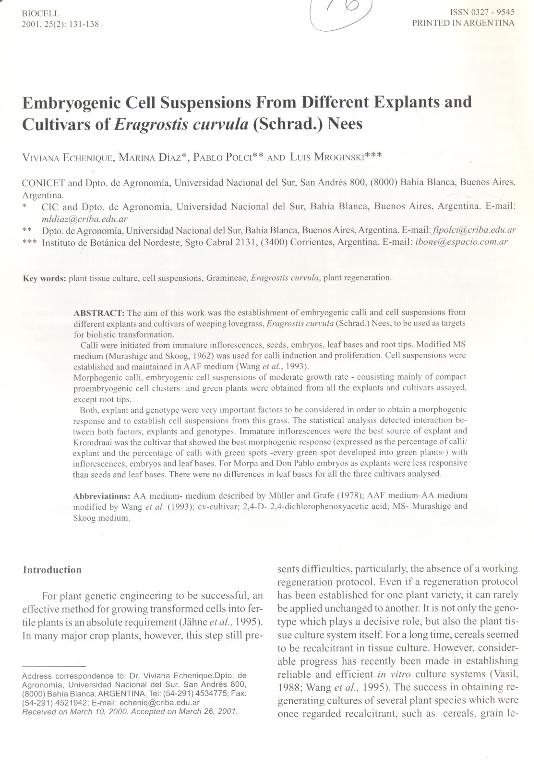Mostrar el registro sencillo del ítem
dc.contributor.author
Echenique, Carmen Viviana

dc.contributor.author
Díaz, Marina
dc.contributor.author
Polci, Pablo Aldo

dc.contributor.author
Mroginski, Luis Amado

dc.date.available
2018-05-14T18:15:13Z
dc.date.issued
2001-12
dc.identifier.citation
Echenique, Carmen Viviana; Díaz, Marina; Polci, Pablo Aldo; Mroginski, Luis Amado; Embryogenic cell suspensions from different explants and cultivars of Eragrostis curvula (Schrad.) Nees; Instituto de Histología y Embriología “Dr. Mario H. Burgos”; Biocell; 25; 2; 12-2001; 131-138
dc.identifier.issn
1667-5746
dc.identifier.uri
http://hdl.handle.net/11336/45111
dc.description.abstract
The aim of this work was the establishment of embryogenic calli and cell suspensions from different explants and cultivars ofweeping lovegrass, Eragrostis curvula (Schrad.) Nees, to be used as targets for biolistic transformation. Calli were initiated from immature inflorescences, seeds, embryos, leafbases and root tips. Modified MS medium (Murashige and Skoog, 1962) was used for calli induction and proliferation. Cell suspensions were established and maintained in AAF medium (Wang et al., 1993). Morphogenic calli, embryogenic cell suspensions of moderate growth rate - consisting mainly of compact proembryogenic cell c1usters- and green plants were obtained from all the explants and cultivars assayed, except root tips. Both, explant and genotype were very important factors to be considered in order to obtain a morphogenic response and to establish cell suspensions from this grass. The statistical analysis detected interaction between both factors, explants and genotypes. Immature inflorescences were the best source of explant and Kromdraai was the cultivar that showed the best morphogenic response (expressed as the percentage of calli/explant and the percentage of calli with green spots -every green spot developed into green plants-) with inflorescences, embryos and leafbases. For Morpa and Don Pablo embryos as explants were less responsive than seeds and leafbases. There were no differences in leafbases for all the three cultivars analysed.
dc.format
application/pdf
dc.language.iso
eng
dc.publisher
Instituto de Histología y Embriología “Dr. Mario H. Burgos”
dc.rights
info:eu-repo/semantics/openAccess
dc.rights.uri
https://creativecommons.org/licenses/by-nc-sa/2.5/ar/
dc.subject
Plant Tissue Culture
dc.subject
Cell Suspensions
dc.subject
Gramineae
dc.subject
Plant Regeneration
dc.subject
Eragrostis Curvula
dc.subject.classification
Ciencias de las Plantas, Botánica

dc.subject.classification
Ciencias Biológicas

dc.subject.classification
CIENCIAS NATURALES Y EXACTAS

dc.title
Embryogenic cell suspensions from different explants and cultivars of Eragrostis curvula (Schrad.) Nees
dc.type
info:eu-repo/semantics/article
dc.type
info:ar-repo/semantics/artículo
dc.type
info:eu-repo/semantics/publishedVersion
dc.date.updated
2018-05-08T21:09:43Z
dc.identifier.eissn
0327-9545
dc.journal.volume
25
dc.journal.number
2
dc.journal.pagination
131-138
dc.journal.pais
Argentina

dc.journal.ciudad
Mendoza
dc.description.fil
Fil: Echenique, Carmen Viviana. Consejo Nacional de Investigaciones Científicas y Técnicas; Argentina. Universidad Nacional del Sur. Departamento de Agronomía; Argentina
dc.description.fil
Fil: Díaz, Marina. Universidad Nacional del Sur. Departamento de Agronomía; Argentina. Provincia de Buenos Aires. Gobernación. Comisión de Investigaciones Científicas; Argentina
dc.description.fil
Fil: Polci, Pablo Aldo. Universidad Nacional del Sur. Departamento de Agronomía; Argentina
dc.description.fil
Fil: Mroginski, Luis Amado. Consejo Nacional de Investigaciones Científicas y Técnicas. Centro Científico Tecnológico Conicet - Nordeste. Instituto de Botánica del Nordeste. Universidad Nacional del Nordeste. Facultad de Ciencias Agrarias. Instituto de Botánica del Nordeste; Argentina
dc.journal.title
Biocell

Archivos asociados
